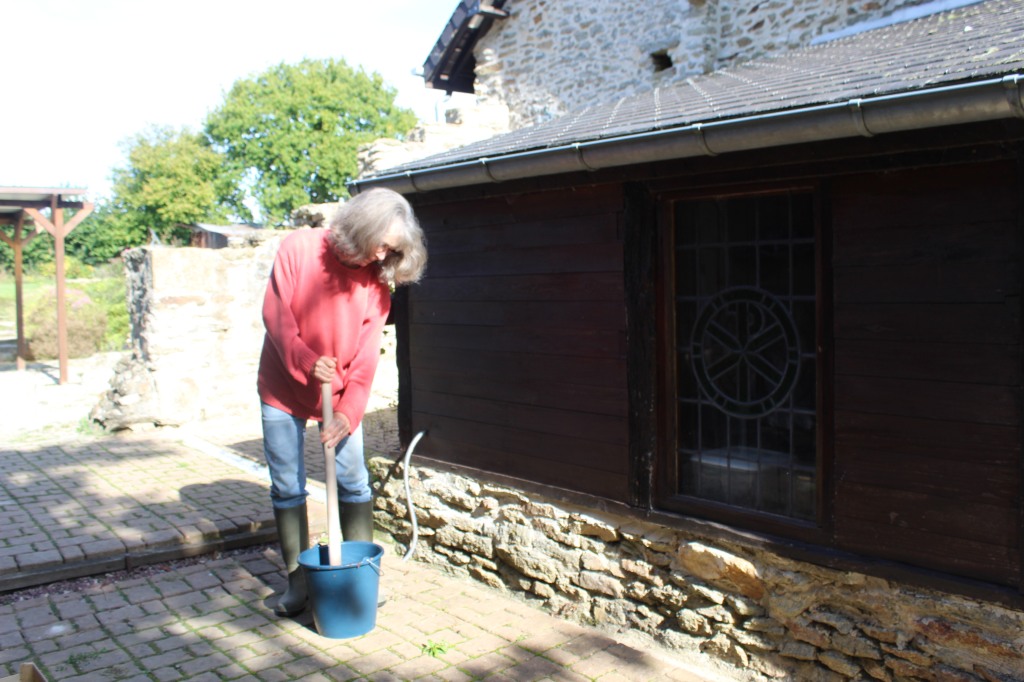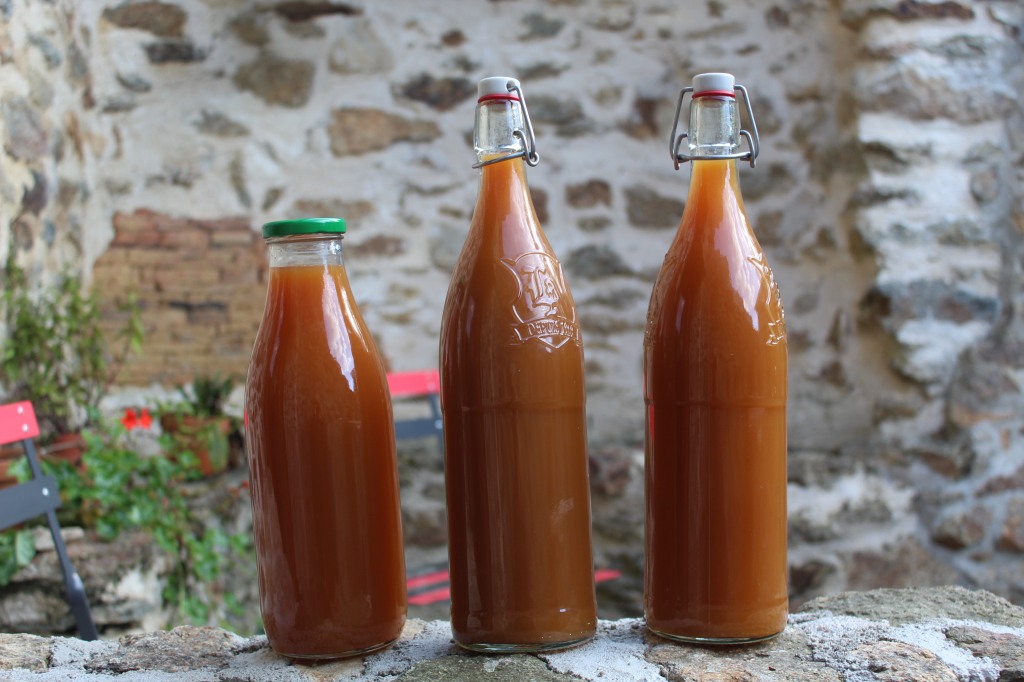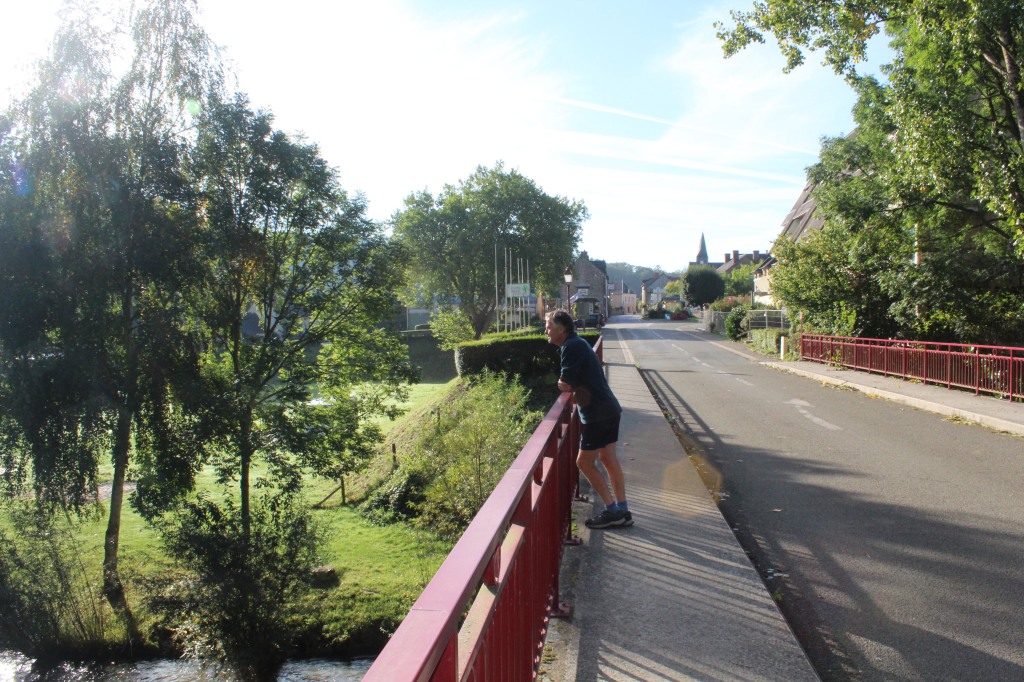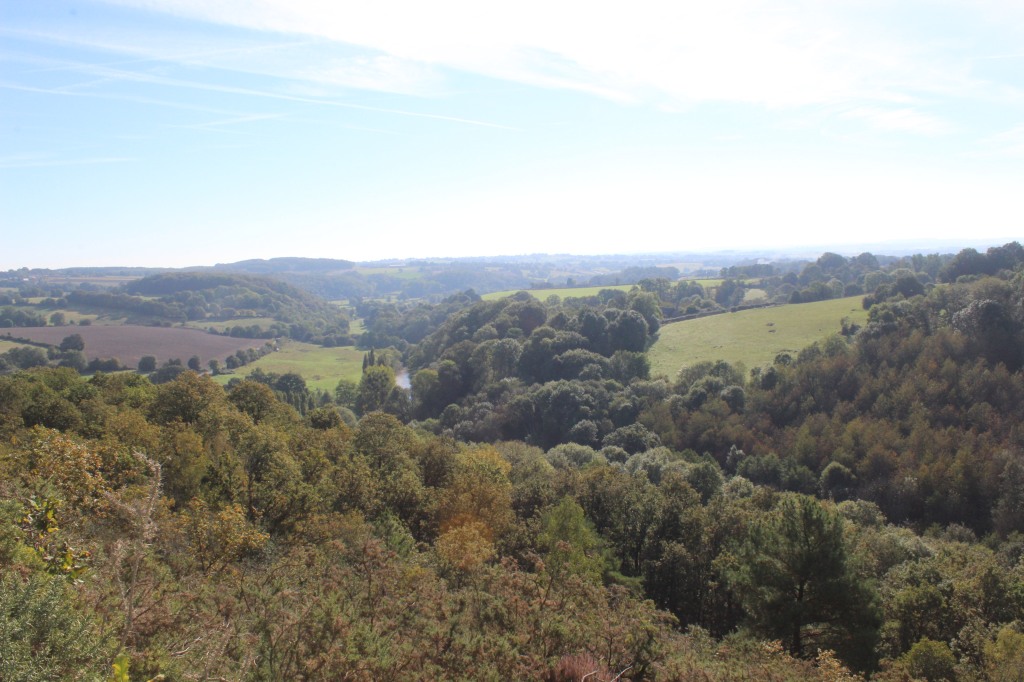We have been blessed with a spell of weather so gorgeous it feels like a blast of summer, mild nights and days so warm and sunny we are back in t-shirts and shorts: this is the Mayenne I remember! The sunshine is golden, the garden full of spider silk and butterflies and heady with the fragrance of apples; the air trills with the songs of woodlarks and is so soft and soapy, you could bathe it in. It is pure bliss and I don’t want to miss a minute. I’ve been spending my days zipping about the garden getting lots done, then picking a trugload or more of beans (Asturian and French) and sitting on the seat in the vegetable patch, shelling them in the late afternoon sunshine and enjoying the moment. I’m not the only one.

The weather is perfect for harvesting apples and we have been filling at least one large crate every day. It’s definitely a two-person job but I’m not sure which role is the more dangerous: wobbling about on top of the ladder and reaching high into the branches to pick the fruit (why are the best ones all at the top?) or standing underneath to catch the dropped apples and transfer them to the barrow, whilst avoiding the inevitable free-fallers. Well, Roger is much braver than me when it comes to heights so just call me Isaac Newton! 😆

It’s certainly worth the work, we have already picked many kilos and there are plenty more to come; from what seemed like a disappointing start flavourwise, we are actually blessed with several trees that produce delicious apples . . . what to do with them all now?

Obviously, we are eating them daily as raw fruit and we will be putting plenty into store and observing how well they keep. They are fine for tarts and the like but don’t cook down into a fluffy pulp like cooking varieties so there’s no point in making compote to freeze. I’m planning to dry as many as I can once the weather turns and drives me indoors but for now, the big story is juice. Our wooden press arrived last week and after a happy hour constructing it, we were keen to try it out. Before pressing, the apples need washing then chopping and mashing into small bits in order to release maximum juice; sane people buy a scratter to sit on top of the press so the apples can be chopped and fed in directly but we didn’t want to rush to buy a whole lot of new equipment before we’d explored just how viable the apple juice project is. So, how to mash? We’re quartering the apples, coring them (not essential but we’ve found it helps), cutting them crossways as chunks seem to mash better than slices then putting them in a food-grade bucket and pounding them with a (new) pickaxe handle. It takes a while but I like this hands-on connection with the whole process and it’s very therapeutic in a vandalistic sort of way.

It’s really not a bad way to spend an hour or so, especially taking it in turns to chop and mash. Our press takes 12 litres of apple pulp so we keep going until it’s full to the top.

The press is a pretty nifty and solid piece of kit engineered from metal and beech wood. Roger was very quick to see that it would need to be bolted down to a board and firmly clamped to the table to stop it dancing about under pressure; he also added several extra wooden blocks on top to raise the height of the handle which gives us more pressing power. So, fully charged, turn the crank and . . .


. . . wow! Juice comes flowing out at great speed into the receptacles below. A full press gives us three to four litres each time which we filter through doubled muslin and then bottle. We’re experimenting with two methods: sterilised plastic bottles to go into the freezer and glass bottles pasteurised in a pan of water to keep in dry storage. We think this year we should yield enough to last us six months which makes us self-sufficient in yet another food for half a year; now we know what we’re doing, we’ll aim for a whole year’s worth next autumn. It might not be the prettiest looking juice in the world, but the flavour is truly amazing. Cheers!

I’m not sure why, but our to-do list just seems to keep on growing – needless to say the poor old kitchen has been abandoned once again, we really will finish the revamp one day. That said, weather like this is such a joy that it would be rude not to make the most of it; after all, cold, wet, dark days will come soon enough so it’s good to grab the chance to get out and about a bit on two wheels or two feet and make the most of this gift. Staying with the theme of apples, it seemed like the perfect chance this week to revisit the apple arboretum at Sainte-Anne, not only to enjoy the trees at their bountiful best, but in the hope of perhaps identifying some of the apple varieties we have in our orchard.

I am always struck by what a beautiful and peaceful place this is, we are so lucky to have it on our doorstep. It is very typical of the shared, respected community spaces that are so abundant in Mayenne and France in general, a welcoming place that can be enjoyed by everyone. The lake is open to fisherfolk in the summer months and there are wooden shelters, benches and plenty of picnic tables; it’s a great spot for families and definitely one on the list for when our little grandmunchkins come to visit. It’s also a popular venue for school fieldtrips, giving children the chance to broaden understanding and experience of their environment and nature at large, as well as local history and culture. I love the fact that several new information boards scattered throughout the arboretum have been based on what the children have written; what a wonderful way to acknowledge, celebrate and encourage them as the future guardians of their locality and the natural world.

Roger sometimes runs this way on his morning outings and I was keen to see the small apiary which he told me had been added since my last visit; as former – and hopefully, future – beekeepers this sort of thing is always interesting and for me, the three hives sited in a fenced area, complete with wooden observation shelter, have made a perfect addition to the arboretum. The bees were boiling out of their hives in the morning sunshine, not to visit fruit blossom, obviously, but it didn’t take too long to see that their flight paths were leading to banks of ivy flowers which make such valuable forage at this time of year.

The arboretum was created in 1992 by grafting donated scions, in an effort to preserve as many local apple varieties as possible; there are currently over 250 mature trees, mostly apples but with the more recent addition of 30 or so pear trees. Seeing the apples in ‘full fruit’ brings home just what an incredible variety there is, the branches dripping with fruits in many shades of green, yellow, orange and red: truly beautiful.


At the entrance to the orchard there is a board and numbered map showing the position of each variety, their musical names creating a rich, linguistic tapestry. I could have spent the whole day simply wandering from tree to tree, appreciating their autumnal beauty but the apple press was calling from home so I had to make do with a quick whizz up and down the rows in search of something that matched the two main varieties we are juicing. I’m not entirely sure I struck gold – needles and haystacks spring to mind – but I think what we have are ‘Binet Rouge’ which is a classic sweet cider apple and ‘De Fer’ which is all good news: late flowering (so unlikely to be frosted), reliable cropper, multi-use fruit with excellent keeping qualities. Can’t say fairer than that.

For our second little wander this week we went back to Saint-Léonard-des-Bois, a pretty town in the nearby Alpes Mancelles which I wrote about earlier in the year. We planned to do a marked 10k / 6 mile walk in two loops, following the fascinating ‘Histoires Géologiques’ route which climbs 275 metres and spans a mere 600 million years! We started at the Domaine du Gasseau picnic site with a flask of coffee and patisserie (a treat we haven’t had for some time) then headed down into Saint-Léonard; the town is built in a loop of the Sarthe river and crossing the first of two bridges, we stopped to enjoy the view.


The town itself is pretty and welcoming, a popular attraction for campers and canoeists in summer and the sort of quiet place where you can just sit outside a cafe and watch the world go by. Passing the mairie and church square, we wandered through narrow streets of ancient houses still boasting colourful floral displays, then climbed steeply out of the town and into leafy woodland.

The woodland was a tranquil place to wander, still green and full of dappled sunlight but in times gone by it was a very different story. This was the site of a flourishing nineteenth-century slate quarry and although it was difficult to imagine the bustle and noise in what is such a peaceful spot today, there were plenty of deep water-filled holes and slate cliffs hinting at the industrial heritage.

Here we found the first of many information boards (in French and English) which were to take us on a fascinating tour through geology and time during our walk, accompanied by samples of various rocks which we could observe and handle. The slates from these quarries were traditionally used for roofs but apparently being high in iron levels as seen in the colour of the rocks – and, I would add, the rich red of the local soil – they had a shorter lifespan than other slates.

The path led us along a ridge above the Vallée de Misère, where in times gone by the trees had been felled for timber and the land heavily grazed; today, it is restored to a wide expanse of mixed woodland full of deciduous trees just on the turn, suggesting that in a couple of weeks’ time the autumn colours will be gorgeous. A little further on at the Butte de Narbonne Sud, the information board told us we were standing on the edge of an ancient volcanic crater an incredible 20 kilometres wide; no volcanic activity today, but the views are beautiful.

We walked along the top of the gorge, the drop below us so precipitous that the local sapeurs-pompiers were using it as a rescue training area, clambering up and down on ropes; we declined their tongue in cheek suggestion of trying the little path they were using down to the river! The views beyond were so typical of Mayenne and Sarthe, a rolling landscape of farmland and woodland dotted with stone houses and barns. We read that the manoir below us was roofed in local slate . . .

. . . and further on, that the ancient cross had been hewn from local stone.

Walking back down into the town to close our first loop, Roger pointed out that the second one would take us to the top of that wooded ridge opposite. Oh good, not done with climbing yet, then!

This time we headed out of town in the opposite direction, crossing the second river bridge; those flowers were a real show.

After a steep climb through woodland on what felt like an ancient trackway, the path opened out into farmland for a while and gave us some more lovely views. The hedgerows were beautiful, still very full and tinged with soft autumn shades, bright with scarlet splashes of hips and haws; bryony and honeysuckle berries were threaded through like brilliant necklaces while spindle berries hung in pink spatters, not yet ready to reveal the vibrant shock of orange seeds hidden inside. This was the oldest part of our geological tour, walking on rocks formed aeons ago in the depths of a southern hemisphere ocean; I always find such information completely mind-blowing. What an incredible planet we live on.

Having reached the summit, we traversed the ridge on a path that felt like a wide woodland ride with bright sunlit clearings along its length. The trees were tall but not dense, giving us tantalising glimpses of the landscape until suddenly everything opened out and there was Saint-Léonard-des-Bois nestling in the valley below us, pretty as a picture.

Following a trail down, we arrived back at our starting point with time for a diversion to the Domaine du Gasseau potager and a quick peep to see how it is faring at this end of the year. There was still plenty of interest and colour thanks to the likes of nasturtiums, borage, Chinese lanterns, amaranth and an abundance of cherry tomatoes still fruiting this late in the season. The kiwi vines were flaunting small fruits and the whole garden was fragrant with the soporific scent of hops trailing over the pergolas. It was as charming as ever, but noticing how the beds were in the process of being mulched with compost and fallen leaves, I realised it was time to stop galavanting and get home to do the same . . . oh, and press another crate of apples in the sunshine, of course. 😊


The apple juice looks amazing! How brilliant is that press? Maybe we visit this time next year and we can all have a go!
I might manage that walk too, especially if there’s the promise of cake at the end if it ….😉
LikeLiked by 1 person
It’s the best thing we’ve bought in ages and a lot of fun, too. The juice is fabulous. I’m beginning to think investing in a scratter would make things a lot quicker and easier although the mashing is a pretty good workout! It’s a beautiful walk, quite a climb in places but one not to be rushed . . . and you could always have a cake at the start AND the finish if needed!!! 🤣
LikeLike
We are apple lovers ourselves. Why a joy to create your own juice! Looks like heaven to me.
And what gorgeous countryside. How beautiful and romantic- all those old cottages and manors! What a wonderful atmosphere.
LikeLiked by 1 person
Hello, Mrs G! It is a truly beautiful area, so peaceful and very rural, still with a strong connection to the seasons and natural world which is why I love it here so much. The apples are wonderful, we had thought they would all be tiny cider varieties so this is a real bonus – heaven indeed!
LikeLiked by 1 person
Yet another wonderful read! Thank you!
LikeLiked by 1 person
🥰
LikeLike
There’s nothing like fresh-pressed cider! Here in New England it is very much a ritual of fall.
LikeLiked by 1 person
. . . and a wonderful ritual at that! After five years with no apple trees we are really making the most of them. Thank you for your comment! 😊
LikeLiked by 1 person
I think it’s time to mull a batch!
LikeLiked by 1 person